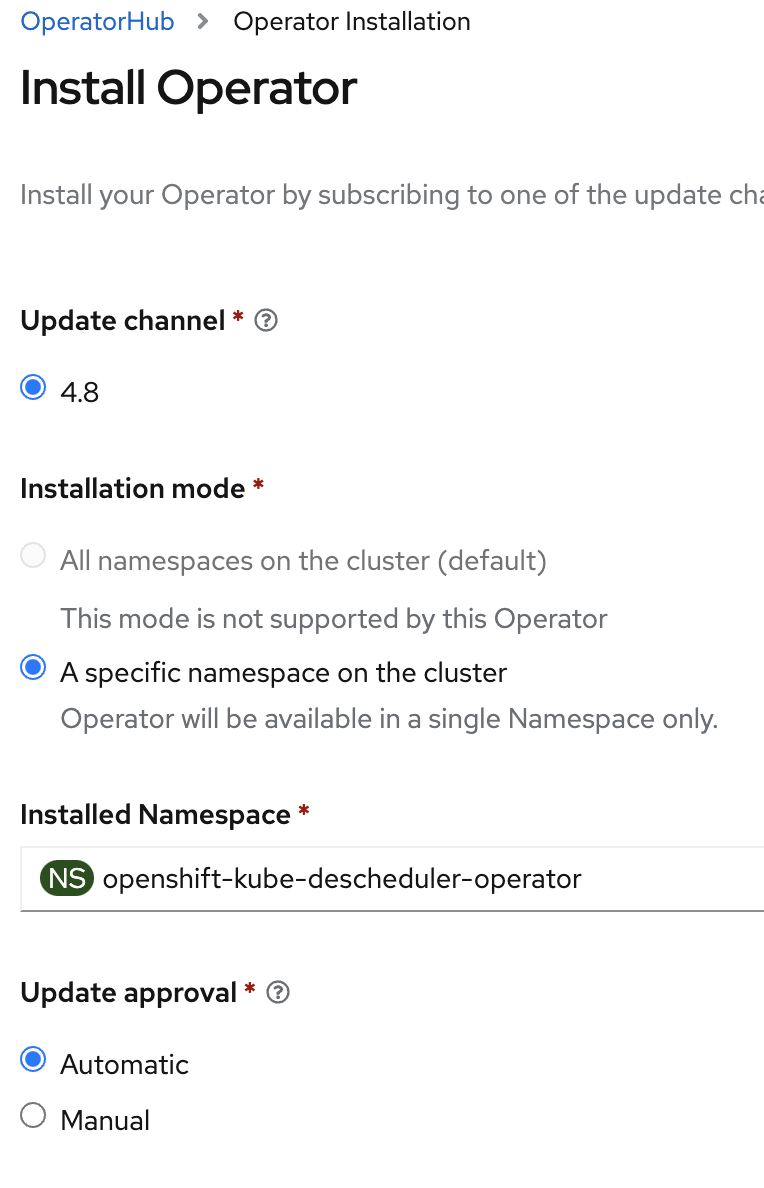Using Descheduler
Descheduler is a new feature which is GA since OpenShift 4.7. It can be used to evict pods from nodes based on specific strategies. The evicted pod is then scheduled on another node (by the Scheduler) which is more suitable.
This feature can be used when:
nodes are under/over-utilized
pod or node affinity, taints or labels have changed and are no longer valid for a running pod
node failures
pods have been restarted too many times
Pod Placement Series
Please check out other ways of pod placements:
Descheduler Profiles
The following descheduler profiles are known and one or multiple can be configured for the Descheduler. Each profiles enables certain strategies which the Descheduler is leveraging. Since the strategies names are more or less self explaining, I did not add their full description here. Instead detailed information can be found at: Descheduler Profiles
AffinityAndTaints- removes pods that violates affinity and anti-affinity rules or taintsRemovePodsViolatingInterPodAntiAffinity
RemovePodsViolatingNodeAffinity
RemovePodsViolatingNodeTaints
TopologyAndDuplicates- evicts pods which are not evenly spreaded or which are violating the topology domainRemovePodsViolatingTopologySpreadConstraint
RemoveDuplicates
LifecycleAndUtilization- evicts long-running pods to balance resource usage of nodesRemovePodsHavingTooManyRestarts - Pods that are restarted more than 100 times
LowNodeUtilization - removes pods from overutilized nodes.
A node is considered underutilized if its usage is below 20% for all thresholds (CPU, memory, and number of pods).
A node is considered overutilized if its usage is above 50% for any of the thresholds (CPU, memory, and number of pods).
PodLifeTime - evicts pods that are too old
Descheduler mechanism
The following rules are followed by the Descheduler to ensure that eviction of pods does not go wild. Therefore the following pods will never be evicted:
pods in openshift-* or kube-system namespaces
pods with priorityClassName equal to
system-cluster-criticalorsystem-node-criticalpods which cannot be recreated, for example: static or stand-alone pods/jobs or pods without a replication controller or replica set
pods of a daemon set
pods with local storage
pods which are violating the pod disruption budget
Installing the Descheduler
The Descheduler is not installed by default and must be installed after the cluster has been initiated. This is done by installed the Kube Descheduler Operator.
First we create a separate namespace for our operator, including a label:
oc adm new-project openshift-kube-descheduler-operator
oc label ns/openshift-kube-descheduler-operator openshift.io/cluster-monitoring=trueThen we search for the Kube Descheduler operator and install it, using the newly created namespace:

After a few moments the operator will be installed.
You can now create a Descheduler instance either via UI (wizard) or by using the following specification:
apiVersion: operator.openshift.io/v1
kind: KubeDescheduler
metadata:
name: cluster
namespace: openshift-kube-descheduler-operator
spec:
deschedulingIntervalSeconds: 3600 (1)
logLevel: Normal (2)
managementState: Managed
operatorLogLevel: Normal (3)
profiles: (4)
- AffinityAndTaints
- TopologyAndDuplicates
- LifecycleAndUtilization| 1 | Defines the time interval the descheduler is running. Default is 3600 seconds |
| 2 | Defines logging for overall component. Can be Normal, Debug, Trace or TraceAll |
| 3 | Defines logging for the operator itself. Can be Normal, Debug, Trace or TraceAll |
| 4 | Enables on or multiple profiles the Descheduler should consider |
Copyright © 2020 - 2025 Toni Schmidbauer & Thomas Jungbauer
 Thomas Jungbauer
Thomas Jungbauer
Discussion
Comments are powered by GitHub Discussions. To participate, you'll need a GitHub account.
By loading comments, you agree to GitHub's Privacy Policy. Your data is processed by GitHub, not by this website.